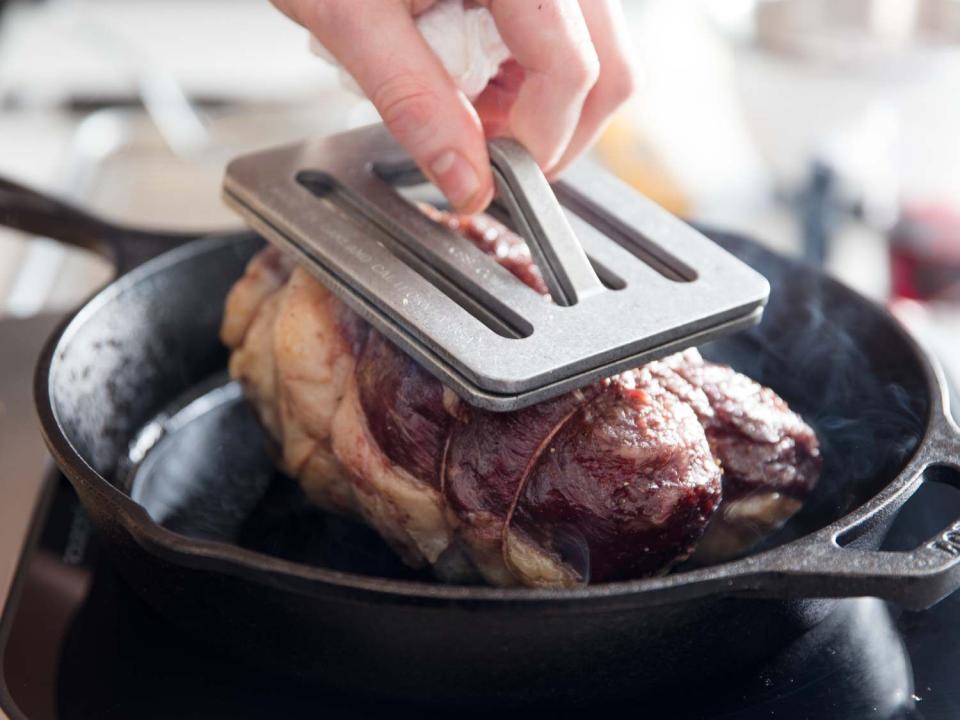Why You Need a Chef's Press in Your Kitchen
These well-designed cooking weights make it easy to maximize cooking surface area.

Serious Eats / Vicky Wasik
We love the Chef's Press. If you're buying one for the first time, the company thinks you should purchase more than one press for maximum utility (and we agree).
Whenever you're searing a piece of meat, crisping the skin on a duck breast or fish fillet, or making a killer grilled cheese sandwich, you want to maximize contact between the food and its cooking vessel. Good things happen when ingredients come in contact with the surface of a hot skillet: They cook quickly and at an even rate, and undergo flavor-boosting chemical changes, like the Maillard reaction. In contrast with the Bluths in prison, this is an instance when touching is strongly encouraged.
So how do we achieve this? Along with using proper cooking techniques—choosing an appropriately sized cooking vessel, not overcrowding it, arranging the food in it in a single layer, and so on—applying weighted pressure to ingredients maximizes the surface area that's directly in contact with the pan, which leads to more delicious browning. This is what makes smashed burgers the best kind of burgers, and produces the crispiest roast chicken skin.
As Daniel proved with his pollo al mattone experiments, there are plenty of ways to weigh down food during cooking. I've used bricks, Dutch ovens, cast iron pans, giant cans of peeled tomatoes, fish spatulas, and my bare knuckles. I'll never forget the time when I was learning how to work a meat station, and my chef jumped behind the line and bailed me out of the steak weeds by MacGyvering weights for 24-ounce bone-in ribeyes out of logs used for the kitchen's wood oven.
A Thoughtfully Designed Weight

Serious Eats / Vicky Wasik
Improvising cooking weights is fun, but not terribly precise or efficient. You don't want to have to check your steaks for splinters before serving them. Fortunately, there are some products on the market that are actually designed for weighing down food during cooking. My favorite is the Chef's Press.
I first came across these weights while working at a restaurant in Chicago, and instantly fell in love with their smart design and performance. As the name suggests, the Chef's Press was actually designed by a chef, which, unfortunately, is kind of rare for kitchen gadgets.

Serious Eats / Vicky Wasik
The Chef's Press is available in two sizes—eight and 13 ounces—and because it's stackable, that weight can be easily adjusted and increased to fit your needs. This makes these weights well suited for holding down delicate items, like fish fillets, that you would normally have to babysit at the stove, pressing down on them with a fish spatula to ensure that the skin remains in contact with the pan and remembering to use just the right amount of even pressure so you don't damage the fish. The Chef's Press frees you up to tend to other things you've got on the stove. And, like a fish spatula, it's vented, allowing steam to escape and keeping whatever you're cooking from getting soggy.
Read More:We Tested 22 Cast Iron Skillets—Here Are the Best Ones
You Put the Load Right on Meat

Serious Eats / Vicky Wasik
Weighing down certain cuts of meat can be tricky due to their shape. Steaks and spatchcocked birds are straightforward: Their relatively flat surfaces are ideal for even skillet contact and browning. A less uniform cut, like a tri-tip roast, is harder to work with. You can certainly perch a small cast iron skillet on top of an oblong roast, but you'll need to use your Jenga skills and focus to keep everything in balance as you turn the meat in the pan to brown it evenly on all sides.
With a few Chef's Press weights, this task becomes a lot easier. They can be stacked one on top of another to create one compact but hefty press, or, for long pieces of meat, like beef tenderloin, they can be shingled over each other for even weight distribution. The handle makes the Chef's Press easy to pick up while you maneuver your protein in the pan.

Serious Eats / Vicky Wasik
These weights are also perfect for using as bacon presses, preventing the pesky ends of rashers from curling up when you're cooking bacon on your stovetop. I find that traditional cast iron bacon presses take up way too much room, and end up getting shoved to the back of some high-up cabinet with other rarely used kitchen tools. With its smaller footprint, the Chef's Press is a lot easier to store. And, unlike a cast iron press, it can be thrown in the dishwasher after you're done using it.
But Weight, There's More

Serious Eats / Vicky Wasik
Chef's Press weights aren't reserved for omnivores—I use them all the time when cooking vegetables. Evenly charring broccoli and asparagus spears is a breeze when you pop a couple of these weights on them. Browning carrots? No problem. You can even use them as sandwich presses for perfectly browned grilled cheese sandwiches.
My favorite kitchen tools are the ones that don't cost a lot of money and get a ton of use, and the Chef's Press definitely falls into that category.
